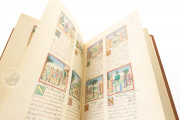The Tacuinum Sanitatis of Prince Eugene—named for a former owner—is an illuminated manuscript describing the characteristics and medicinal uses of plants, animals, and minerals. It was created in the Veneto in the late fifteenth century. A miniature precedes each description. Of its 294 miniatures, 125 are fully painted, six are partially painted, and 163 are represented by their underdrawings without paint. The manuscript's interest lies both in the quality and lively human figures of the fully painted illustrations and the glimpse of its genesis afforded by its incomplete state.
The Latin text, Tacuinum sanitatis ("tables of health") is a thirteenth-century Latin translation of an eleventh-century Arabic text by Ibn Buṭlān. It takes its name from the Arabic word taqwim, meaning "tabular register," after the format of the Arabic treatise.
Farmers and Merchants
The charm of Eugene's manuscript lies in the depiction of contemporary people interacting with the substances that are the book's subject. There are rural scenes, such as growers collecting a harvest from their lemon trees (fol. 5v). More often, the artist offers a glimpse of the Renaissance marketplace, as in the illustration for "Indian and Palestinian melons" (fol. 6r).
Plants and Animals
The content is arranged according to type of substance, starting with plants (trees, herbs, grains), animals and animal parts, and prepared foods. It ends with a section on human behaviors. More than half of the text is devoted to plant substances (fols. 1v-17v), as would be expected, but there are some surprising inclusions, such as the meat of bears, which is illustrated by a group of naked children leading a bear on a leash (fol. 21v).
Nature and Utility
Each substance is characterized by its quality—whether cold or hot, dry or damp—and its medicinal uses, side effects, and remedies for side effects are listed. The terse text, although presented as prose, clearly reveals the tabular format of the Arabic original.
Green and Red Ink
For each substance, the name is written in green as a heading. Then follows the description, with the sections in order (their names in red): naturae, melius ex eis/ea, iuvamentum, nocumentum, remotio nocumenti (literally, natures, the best of them, help, harm, removal of harm). Each description is presented in trompe l'oeil ("fool the eye") as a piece of parchment or paper attached to the page and peeling at its edges.
A Twin Text
The text of Prince Eugene's manuscript is nearly identical to that of the Casanatense Theatrum Sanitatis, copied a century earlier in Milan. The format of the earlier manuscript is different, though, and it is an innovation of Eugene's manuscript to present the text in Humanistic Minuscule in two columns with the substances grouped four to a page.
Part of the Library of the Prince of Savoy
The distinguished military leader Eugene of Savoy (1663-1736), Prince of Savoy, owned the manuscript. His library, prints, and drawings were purchased from his widow by Charles VII (1697-1745), Holy Roman Emperor, in 1737 and have since passed into Austrian national collections. The binding of light brown morocco with gold tooling over pasteboard dates from the eighteenth century.
We have 1 facsimile edition of the manuscript "Tacuinum Sanitatis of Prince Eugene": Tacuinum Sanitatis facsimile edition, published by Akademische Druck- u. Verlagsanstalt (ADEVA), 1984
Request Info / Price



















